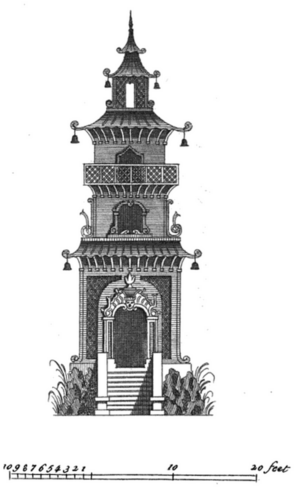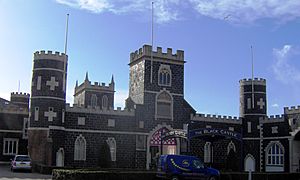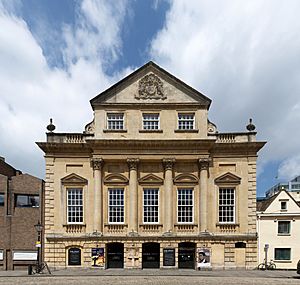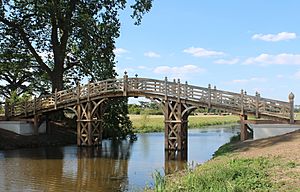William Halfpenny facts for kids


William Halfpenny was an English architect and builder who lived in the 1700s. He was very famous for writing many books that helped other builders and people who wanted to design their own homes. He called himself an "architect and carpenter" in his books.
His books were a cheaper choice compared to very expensive architecture books by other famous designers. Halfpenny even wrote a short book to "correct" some mistakes he found in the works of a famous architect named Palladio. He also sometimes used the name Michael Hoare.
We don't know much about Halfpenny's personal life. He seemed to live mostly in Richmond, near London, and maybe also in Bristol for a while. He also worked in Ireland. Not many big buildings are definitely known to be his work. His main importance comes from his books, which were printed many times and copied by others. His ideas even reached North America and were used there. Later in his career, he worked with his son, John Halfpenny. Many of his later books and some buildings he designed were in the "Gothick" (Gothic Revival) and "Chinese taste" styles.
Contents
Halfpenny's Life and Building Projects
We don't know many details about William Halfpenny's early life. In 1723, he was paid for a design for a church in Leeds, but it was never built. His book Practical Architecture (1724) was dedicated to a landowner and Member of Parliament named Sir Thomas Frankland.
His book The Art of Sound Building (1725) was dedicated to a government official, Sir Andrew Fountaine. In 1726, Halfpenny suggested a design for a bridge over the River Thames in Fulham. Another writer, Batty Langley, mentioned Halfpenny in his book Ancient Masonry (1736), calling him "Mr William Halfpenny, also known as Hoare, who used to live in Richmond in Surrey, a carpenter."
Working in Ireland
Halfpenny spent some time working in Ireland. In 1732, he designed a building for horses (a horse barracks) in Hillsborough for Lord Hillsborough. In 1737, he designed Garrahunden House, which was later taken down, near Bagenalstown. This house was for Sir Richard Butler. In 1739, Halfpenny created designs for buildings in the cities of Waterford and Cork.
Halfpenny's Work in Bristol
Most of the buildings that might have been designed by Halfpenny are in or around Bristol. He probably lived there starting around 1730. His book Perspective Made Easy, published in 1731, included many pictures of Bristol.
The Coopers' Hall on King Street in Bristol is the most important building that we know for sure was designed by him. It was built between 1743 and 1744. The Coopers (people who make barrels) stopped using it in 1785. Later, it was used for parties, as a storage building, and even as a church. Since 1972, the ground floor has been the main entrance to the Bristol Old Vic theatre. The upper floors are now used for different theatre activities.
The Chinese Bridge at Croome Court
Only one other project that is definitely Halfpenny's work still has parts remaining. This is a "Chinese" bridge built for Lord Deerhurst at Croome Park in Worcestershire. It was built between 1747 and 1748.
In 2009, students studying archaeology found the strong stone foundations of this bridge. The National Trust, a group that protects historic places, built a copy of the bridge. They used Halfpenny's original drawing to recreate it. This was part of a plan to bring back the original garden design by Capability Brown.
William Halfpenny passed away in 1755 and was in debt at the time.
Buildings Possibly Designed by Halfpenny
Here are some other buildings that experts think Halfpenny might have designed because of their style:
- King House, Boyle, County Roscommon (built between 1720 and 1730)
- The Ivy, Bath Road, Chippenham, Wiltshire (built in 1728)
- Frampton Court, Frampton-on-Severn, Gloucestershire (built between 1731 and 1733)
- Redland Chapel in Bristol: This chapel has been thought to be Halfpenny's work. However, it was probably designed by John Strahan, who died before it was finished. Halfpenny was hired in 1742 to finish the work.
- No.3, Clifton Hill, Clifton, Bristol (built in 1742): This building was once called Clifton Court and is now a nursing home called Chesterfield. It is a very important historic building.
- Stouts Hill, near Uley, Gloucestershire (built in 1743)
- Black Castle Public House, Brislington, Bristol (built between 1745 and 1755)
- Church of St Margaret, Babington, Somerset (around 1748)
- An orangery (a type of greenhouse for orange trees) or a Gothick garden house, The Green, Frampton-on-Severn (around 1750)
- Upton House near Tetbury, Gloucestershire (built in 1752)
Images for kids
-
Plate 55, "The Elevation of a Chinese Gazebo", from Rural Architecture in the Chinese Taste, 1755, in which the word "gazebo" is first recorded in English
-
Black Castle, Bristol, perhaps by Halfpenny







